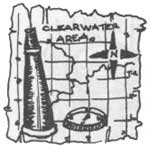|
The Clearwater Story: A History of the Clearwater National Forest |

|

Chapter 8
Maps
The oldest maps of portions of the Clearwater Forest are those drawn by Captain Clark of the Lewis and Clark Expedition. These maps cover the route they traveled and are very inaccurate. Their chief value is in tracing their actual route and in learning where events of that expedition took place. One volume of Thwaite's Journal is devoted to Lewis and Clark's maps.
In 1862 Giddings prepared a map which covered the Clearwater area. It shows the names of creeks around Pierce. One interesting thing about this map is that it shows Lolo Creek as the Lo Lo Fork. However, he got the creek too long by showing it heading at Lo Lo Pass. This is further evidence that the early miners named Lolo Creek, Trail, and Pass.
A map, dated 1865, was drawn by DeLacy, an engineer for the Northern Pacific Railway Company. It was on a small scale and very crude, but it shows Pierce City, the old town of Oro Fino, and the road from Lewiston to the mining country. The Lolo Trail is shown as it is today, but Lolo Creek in Montana is called Lou Lou Creek. The Lochsa is called the Salmon Fork.
The next oldest map is one prepared by Asker and Adams in 1874 and shows the Northern Pacific survey down the North Fork. The location of the North Fork is very accurate, otherwise the map is quite inaccurate. The Little North Fork is named. Lolo Creek is called Lo Lo Fork. Pierce City is shown, but not Oro Fino. Apparently it had ceased to exist. Orofino Creek is named, but no other creek names are shown. The Lolo Trail is omitted.
Lt. Robert Fletcher drew a sketch of the Clearwater country to accompany General Howard's report on the Nez Perce Indian War in 1877. This map is very poor. The only new feature named is Musselshell Creek. Howard's camps on the Clearwater Forest are shown, but there are no identifying features.
In 1894 Lt. Elliott prepared a map of the country around the mouth of Warm Springs Creek. He shows Parson's and Isaac's graves. He also shows Colgate Hot Springs and since he buried Colegate, he can be credited with putting this name on the map.
In 1898 J.B. Leiberg made a map of the Bitter Root Forest Reserve. Most of this map covers the Selway, but the upper Lochsa and the Blacklead countries are included. His map was fairly accurate but, of course, lacked detail. On this map Rhodes Peak, Indian Post Office, Sherman Peak, Castle Butte, Rocky Ridge and Weitas Meadows are named.
In 1902 the Land Office started to sectionize townships 37-6, 37-7, 37-8, 37-9, 38-8, 39-7 and 40-7. These townships were at that time outside the National Forest boundary. They made maps as their work proceeded. Their survey ran from 1902 to 1907.
In about 1908 the Forest Service put together in one map all the known surveys up to that time. The gaps in the information were filled in "by guess and by golley". A blueprint of this map was made and this map served until it was replaced by a U.S.G.S. map in 1913.
In 1911 the U.S.G.S. made a field survey of a large part of the Clearwater Forest. The survey was under S.G. Lunde. This was a contour map and was by far the best map the Clearwater Forest had up to that time. The map came out late in 1913.
In 1914 a cruise of the Eldorado, Lolo, Musselshell country produced a good contour map of that area.
In 1915 to 1917, F.E. Bonner, J.B. Yule and K.D. Swan of the Division of Maps and Surveys in the District (now Regional) Office compiled a map of the Clearwater Forest. This map combined all previously known maps. The result was a contour map on a 1/2-inch and also a 1-inch to the mile scale. This was the best map of the Clearwater Forest that had ever been prepared. With revisions in 1926, 1936 and 1942 to show added roads, trails, lookouts, and telephone lines it served until maps prepared from aerial photos took its place.
Today 3/8-inch scale maps are issued for each Ranger District and a 1/2-inch scale map is issued for the Forest. These are aerial photo maps and are very accurate.
| <<< Previous | <<< Contents>>> | Next >>> |
|
clearwater/story/chap8.htm Last Updated: 29-Feb-2012 |